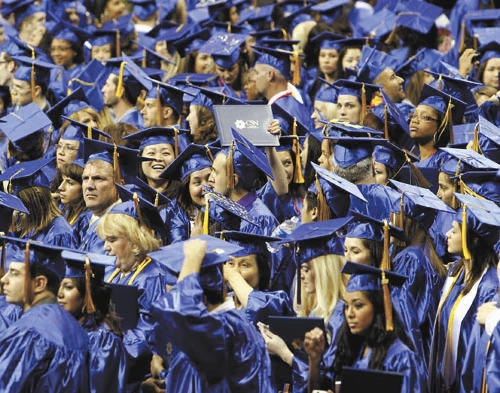Higher ed cuts: not as bad as feared


The budget deal brokered by legislators and the governor will mean tuition and fee increases, pay cuts, job losses, and that thousands of students will be shut out of the state’s colleges and universities.
And higher education leaders say that is pretty good news.
While they weren’t exactly jumping for joy on Thursday, they were glad things weren’t as bad as they could have been.
“I think we all understand in higher education that this budget could have been much, much worse, but I don’t think anybody should be under the illusion that there aren’t still very significant cuts to be made,” Chancellor Dan Klaich said. “Access will be limited. Layoffs will occur.”
But he said none of the state’s campuses will have to close, and the system will not have to declare financial exigency — a drastic declaration similar to corporate bankruptcy.
State higher education officials had been planning for as many as 1,500 job losses, the elimination of dozens of programs, shutting out as many as 20,000 students and possibly closing some campuses. They have been saying for months that Gov. Brian Sandoval’s budget proposal would leave them no choice.
But the governor and lawmakers were able to avoid the worst of the cuts by agreeing to keep some tax increases that were due to expire. The deal was announced late Wednesday.
Exact figures were hard to come by, but officials said it should mean a 12 percent to 15 percent cut for higher education instead of a 29 percent cut.
Klaich estimated that the smaller cut would reduce the number of students shut out and the number of layoffs by two-thirds each. That would mean about 500 job losses and about 7,000 students kept out because there is no room for them.
UNLV President Neal Smatresk said he was optimistic that he would be able to avoid the worst scenarios, such as shutting down 36 degree programs and eliminating some 300 jobs.
He said a priority now will be honoring faculty tenure. Plans had called for laying off faculty in programs that were eliminated, even if those faculty members were tenured.
“We exist in a global marketplace, and we compete for top faculty,” Smatresk said. “If you don’t honor tenure, you get yourself in trouble.”
He said the smaller cuts will help the university avoid eliminating as many programs as he had feared, but that doesn’t mean there won’t be any eliminations. These cuts come on top of cuts made in each of the past three fiscal years.
“As far as program eliminations, a significant number will still occur, but they won’t occur by relieving tenured faculty of their positions,” he said.
He said it was too early to say how many programs and jobs would be eliminated. He said he will consult faculty leaders and come up with a preliminary plan next week.
College of Southern Nevada President Michael Richards said the college’s Henderson campus — one of three based in and around Las Vegas — will remain open.
He was less sure about the nine satellite centers CSN operates. He said he “might be able to keep a number of them open,” but he was as yet unsure.
He had estimated that the larger cuts could mean shutting out 13,000 students at CSN but said that number should be cut in half. Last fall, the community college had turned away more than 5,000 because available classes were full.
The system’s governing Board of Regents will hear cut proposals from all eight institutions at its next meeting, set for June 16 and 17 in Reno.
The approved state funding is about $40 million higher in each of the next two fiscal years than Sandoval’s original proposal.
That is similar to funding levels the higher education system asked for in April, when Klaich presented a plan to the Legislature. That plan called for the additional revenue and 13 percent student fee increases in each of the next two years.
Gregory Brown, a UNLV history professor and president of the UNLV chapter of the Nevada Faculty Alliance, said a significant concern is whether those fee increases will happen.
A legislative committee issued a letter of intent — a nonbinding request, in effect — that student fee increases not exceed a total of 13 percent.
If that request is honored, fee revenues could be $20 million or more lower than the system had planned for.
Klaich said he doubts the board will ignore the Legislature’s request to cap the fee increases at 13 percent.
Contact reporter Richard Lake at rlake@reviewjournal.com or 702-383-0307.












